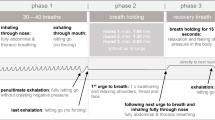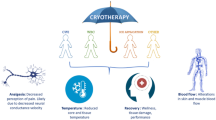Abstract
To clarify the influence of internal and skin temperature on the active cutaneous vasodilation during exercise, the body temperature thresholds for the onset of active vasodilation during light or moderate exercise under different ambient temperature conditions were compared. Seven male subjects performed 30 min of a cycling exercise at 20 % or 50 % of peak oxygen uptake in a room maintained at 20, 24, or 28 °C. Esophageal (Tes) and mean skin temperature (Tsk) as measured by a thermocouple, deep thigh temperature (Tdt) by the zero-heat-flow (ZHF) method, and forearm skin blood flow by laser-Doppler flowmetry (LDF) were monitored. The mean arterial pressure (MAP) was also monitored non-invasively, and the cutaneous vascular conductance (CVC) was calculated as the LDF/MAP. Throughout the experiment, the Tsk at ambient temperatures of 20, 24, and 28 °C were approximately 30, 32, and 34 °C, respectively, for both 20 % and 50 % exercise. During 50 % exercise, the Tes or Tdt thresholds for the onset of the increase in CVC were observed to be similar among the 20, 24, and 28 °C ambient conditions. During 20 % exercise, the increase in Tes and Tdt was significantly lower than those found at 50 %, and the onset of the increase in CVC was only observed at 28 °C. These results suggest that the onset of active vasodilation was affected more strongly by the internal or exercising tissue temperatures than by the skin temperatures during exercise performed at a moderate load in comparison to a light load under Tsk variations ranging from 30 °C to 34 °C. Therefore, the modification by skin temperature of the central control on cutaneous vasomotor tone during exercise may differ between different exercise loads.



Similar content being viewed by others
References
Benzinger TH (1959) On physical heat regulation and sense of temperature in man. Proc Natl Acad Sci USA 45:645–659
Brengelmann GL, Savage MV (1997) Temperature regulation in the neutral zone. Ann NY Acad Sci 813:39–50
Charkoudian N (2010) Mechanisms and modifiers of reflex induced cutaneous vasodilation and vasoconstriction in humans. J Appl Physiol 109:1221–1228
Charkoudian N, Johnson JM (1999) Reflex control of cutaneous vasoconstrictor system is reset by exogenous female reproductive hormones. J Appl Physiol 87:381–385
Fox RH, Solman AJ, Isaacs R, Fry AJ, MacDonald IC (1973) A new method for monitoring deep body temperature from the skin surface. Clin Sci 44:81–86
Hertel H, Howaldt B, Mense S (1976) Responses of group IV and group III muscle afferents to thermal stimuli. Brain Res 113:201–205
Jessen C, Feistkorn G, Nagel A (1983) Temperature sensitivity of skeletal muscle in the conscious goat. J Appl Physiol 54:880–886
Kacin A, Golja P, Eiken O, Tipton MJ, Gorjanc J, Mekjavic IB (2005) Human temperature regulation during cycling with moderate leg ischaemia. Eur J Appl Physiol 95:213–220
Kellogg DL, Johnson JM Jr, Kosiba WA (1991) Control of internal temperature threshold for active cutaneous vasodilation by dynamic exercise. J Appl Physiol 71:2476–2482
Kenny GP, Periard J, Journeay WS, Sigal RJ, Reardon FD (2003) Cutaneous active vasodilation in humans during passive heating post exercise. J Appl Physiol 95:1025–1031
Kondo N, Nishiyasu T, Inoue Y, Koga S (2010) Non-thermal modification of heat-loss responses during exercise in humans. Eur J Appl Physiol 110:447–458
Kume M, Yoshida T, Tsuneoka H, Kimura N, Ito T (2009) Relationship between heat extraction, skin blood flow, and changes in core temperature responses during steady exercise wearing water perfused suits. Jpn J Biometeorol 46:159–168
Matsukawa T, Kashimoto S, Ozaki M, Shindo S, Kumazawa T (1996) Temperatures measured by a deep body thermometer (Coretemp) compared with tissue temperatures measured at various depths using needles placed into the sole of the foot. Eur J Anaesth 13:340–345
Mekjavic IB, Eiken O (2006) Contribution of thermal and nonthermal factors to the regulation of body temperature in humans. J Appl Physiol 100:2065–2072
Mekjavic IB, Remple ME (1990) Determination of esophageal probe insertion length based on standing and sitting height. J Appl Physiol 69:376–379
Mitchell JW, Nadel ER, Stolwijk JAJ (1972) Respiratory weight loss during exercise. J Appl Physiol 32:474–476
Muravchick S (1983) Deep body thermometry during general anesthesia. Anesthesiology 58:271–275
Nadel ER, Mitchell JW, Stolwijk AJ (1979) Differential thermal sensitivity in the human skin. Pfügers Arch 340:1084–1089
Nagamine S, Suzuki S (1964) Anthropometry and body composition of Japanese young men and women. Human Biol 36:8–15
Pergola PE, Kellogg DL Jr, Johnson JM, Kosiba WA (1994) Reflex control of active cutaneous vasodilation by skin temperature in humans. Am J Physiol 265 (Heart Circ. Physiol 35): H1979–H1984
Pergola PE, Johnson JM, Kellogg DL Jr, Kosiba WA (1996) Control of skin blood flow by whole body and local skin cooling in exercising humans. Am J Physiol 270 (Heart Circ. Physiol 39): H208–H215
Smolander J, Saalo J, Korhonen D (1991) Effect of work load on cutaneous vascular response to exercise. J Appl Physiol 71:1614–1619
Stephens DP, Aoki K, Kosiba WA, Johnson JM (2001) Nonnoradrenergic mechanism of reflex cutaneous vasoconstriction in men. Am J Physiol Heart Circ Physiol 280:H1496–H1504
Taylor WF, Johnson JM, Kosiba WA, Kwan CM (1988) Graded cutaneous vascular responses to dynamic leg exercise. J Appl Physiol 64:1803–1809
Togwa T, Nemoto T, Yamazaki T, Kobayashi T (1976) A modified internal temperature measurement device. Med Biol Eng 14:361–364
Wenger CB, Roberts MF, Stolwijk JAJ, Nadel ER (1975) Forearm blood flow during body temperature transients produced by leg exercise. J Appl Physiol 38:58–63
Wissler EH (2008) A quantitative assessment of skin blood flow in humans. Eur J Appl Physiol 104:145–157
Wyss CR, Brengelmann GL, Johnson LM, Rowell LB, Silverstein D (1975) Altered control of skin blood flow at high skin and core temperature. J Appl Physiol 38:839–845
Yamakage M, Namiki A (2003) Deep temperature monitoring using a zero-heat-flow method. J Anesth 17:108–115
Yamakage M, Iwasaki S, Namiki A (2002) Evaluation of a newly developed monitor of deep body temperature. J Anesth 16:354–357
Author information
Authors and Affiliations
Corresponding author
Rights and permissions
About this article
Cite this article
Demachi, K., Yoshida, T., Kume, M. et al. The influence of internal and skin temperatures on active cutaneous vasodilation under different levels of exercise and ambient temperatures in humans. Int J Biometeorol 57, 589–596 (2013). https://doi.org/10.1007/s00484-012-0586-y
Received:
Revised:
Accepted:
Published:
Issue Date:
DOI: https://doi.org/10.1007/s00484-012-0586-y




